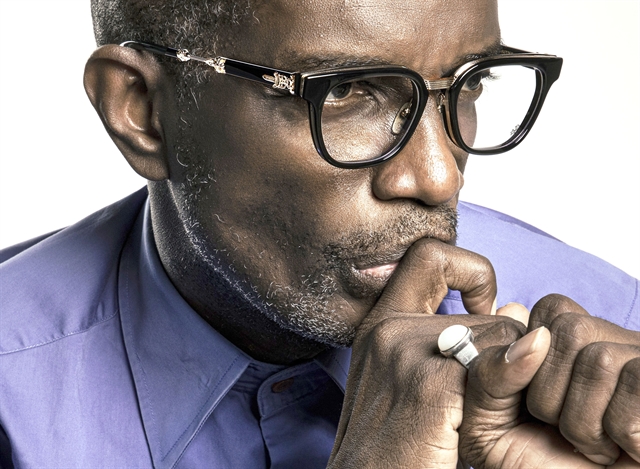 Features
Features

With more than 37 years experience in the fashion industry and 15 years in Vietnam, Henri Hubert, creative director of Le Nom Group, a visual communication agency, believes sustainability should be the top priority for the industry. He speaks to Việt Nam News about sustainable fashion trends emerging amid the COVID-19 pandemic. Bồ Xuân Hiệp reports.

|
| Henri Hubert, creative director of Le Nom Group, a visual communication agency, believes sustainability should be the top priority for the fashion industry. Photos courtesy of Henri Hubert |
With more than 37 years experience in the fashion industry and 15 years in Việt Nam, Henri Hubert, creative director of Le Nom Group, a visual communication agency, believes sustainability should be the top priority for the industry. He speaks to Bồ Xuân Hiệp about sustainable fashion trends emerging amid the COVID-19 pandemic.
Inner Sanctum: What do you think about the impact of the pandemic on the fashion industry, especially towards sustainability in terms of design, manufacturing, and use of eco-friendly materials?
The pandemic has created a dramatic contraction in demand and production in the fashion industry, one of the sectors hardest hit by the crisis. The resulting economic shutdowns have created unprecedented challenges for the industry, including a decline in consumer spending and disrupted supply chains.
This could help accelerate a shift to greener, more sustainable supply chains, which will not only be critical for companies but will also impact the future of the fashion industry as a whole.
Sustainability has been identified as one of the top priorities for the fashion industry. Improving raw material sourcing with better recycling processes, reducing water consumption, and replacing hazardous chemicals with safer alternatives are some of the measures that can reduce fashion’s environmental footprint and help the industry survive in the new business scenario.
I think fashion houses have been forced to reinvent themselves. Those who were able to do so transformed their production lines. For example, they made masks and gowns for hospital staff and doctors. They also redesigned their collection to be more current, with styles more adapted to the psychological aspect of the moment. The materials were also seen, reviewed and corrected.

|
| With more than 37 years experience in the fashion industry and 15 years in Việt Nam, Henri Hubert believes sustainability should be the top priority for the industry |
Inner Sanctum: Environmental concerns are increasingly important among consumers who are calling for environmentally friendly practices in the fashion industry. What are the sustainability trends in the industry?
The unprecedented crisis that the fashion and luxury industry has been going through since the beginning of the pandemic is forcing it to rethink its operations from top to bottom.
This economic shock must also be an opportunity to take action to reduce the negative social and environmental impact of the sector as the United Nations says in a call for a more responsible recovery.
The question now is ‘How can we build back better?’ The environmental facts are clear. The fashion industry alone is responsible for 8 to 10 per cent of global carbon dioxide emissions, which is more than international flights and shipping combined. These emissions are mainly related to the production of raw materials, textile manufacturing and the transportation of finished products.
The water footprint is equally catastrophic. Another recent United Nations report estimates that about 93 billion cubic metres of water -- enough to meet the needs of five million people -- are used each year by the fashion industry. It takes 7,000 litres of water to make a single pair of jeans, the equivalent of the water drunk by a human for seven years.
The biggest environmental impact of fashion is related to the washing of clothes, not only because of the water and energy used but also because of the water and soil pollution it causes.
According to the United Nations Conference on Trade and Development, 500,000 tonnes of plastic microfibres, the equivalent of 3 million barrels of oil, are dumped into the oceans each year. In addition, textile dyeing is the second largest contributor to water pollution in the world.
These are scary figures. Sustainability will be an important issue for consumers as far as brands are concerned, and current and future consumers. And I’m not talking about greenwashing but ‘real sustainability’.
The best thing is that we understand that our individual actions have societal consequences. Sustainability matters and will matter more and more.
I see a growing concern for employees of fashion companies as well. The same people who are consumers on the one hand are employees on the other. When executives, managers and employees support sustainability, it can have a positive self-reinforcing impact on the corporate culture.
Any fashion company is only as good as the talent it can attract, and the fashion talent of the future will want to work for fashion companies that make sustainability the keyword. So let’s keep hoping.
Inner Sanctum: We are living in a ‘throwaway’ culture and fashion waste has been increasing. What do you think about buying secondhand clothing as an option to reduce environmental impact?
Oh my, I love your question, you fall right in my passion! Buying secondhand clothing is a habit that has become more common, which is good.
In recent years, mentalities have evolved enormously to the point that in 2020 72 per cent in the world had bought or were considering buying secondhand, while a few years ago it was 50 per cent.
I lived in this context in France, where it was already very fashionable to dress vintage. For many reasons, personally, for me, it was the taste of ‘the well-done, the well-finished, the different.’ I loved the details of the clothes of my father. All of this came from a certain education in fashion.
Today in Việt Nam in my entourage I see a certain craze. Purchasing secondhand has many advantages, and it can be of incredible help for the industry, and especially for us wellness lovers.
Let me explain. It allows us to save money. The first good reason to buy secondhand, and not the least, is that it saves money. It helps reduce the environmental impact of a garment. Buying secondhand can extend the life of a garment by several weeks, months or years -- the longer the better, of course.
It also helps reduce textile waste. According to studies by an American giant of online resales, one out of two Americans throw the clothes they want to get rid of directly into the trash. The result is that 62 per cent of the 30 billion clothes produced each year end up in landfills.
You can also find unique pieces. When we buy secondhand, we are far from the mass offerings of fast-fashion, and it is so much better. It allows you to find unique pieces, which is even more true if you buy vintage.
The secondhand offering is now so vast that it is possible to find absolutely everything, including good basics: jeans, black cigarette pants, white blouses, black boots, and sometimes items that have never been worn.
Buying secondhand clothes is choosing another model than one of mass production. It is a mode of consumption that opposes fast-fashion.
Inner Sanctum: New fashion styles are available almost every day. What do you think about the concept of fast fashion which has revolutionised the industry over the past decade?
Fast fashion concerns fashion brands that renew their collections very regularly to produce at low cost and sell at low prices.
Fast fashion appeared in the early 1990s with the arrival of brands like Zara in fashion epicentres such as New York or London. But it was in the late 1990s and early 2000s that low-cost fashion reached its peak with the series of brands we know today, which have become veritable empires such as H&M, Topshop, Gap, and, of course, Zara.
The recipe of fast fashion is simple: very regular renewal of collections by seasons or even by months or weeks, low prices, and reduced stocks. The process must be fast: the brands propose new collections as soon as a new trend emerges from the catwalks, celebrities, or the street.
This definition hides an unglamorous reality: sweatshops, sanitary and ecological disasters, human dramas, discrimination, and so on. Yet its consequences seem far away. And as they say, out of sight, out of mind.
But fast fashion is here, implanted in our daily life, even in our underwear. And its consequences are also very present. At a time of awakening consciousness and the development of sustainable and eco-responsible fashion, fast fashion cannot remain opaque and closed in on itself.
In response, they try to make us forget what is hidden behind our labels, with discounts, sales and other advertising to push us to consume more and more, and faster.
But to understand is to be able to make a choice. And as consumers, we can choose to become full-fledged actors in the textile industry. After all, if we choose to consume ethical fashion, fast fashion will be nothing.
The price to pay with fast fashion is high. The real price is not visible when you buy it. However, its damage on the planet and on people is immeasurable. If you don’t pay, someone else will.
There is an environmental downside to fast fashion. The flip side of low prices is the pressure on resources. Fast fashion still favours non-renewable, petro-sourced materials like polyester, elastane, nylon or even acrylic. Crops and transformation processes such as dyeing also require a significant amount of chemicals.
Unfortunately, most people are far from all of this, and think “cheaper, faster, new styles are all good for us”. VNS




